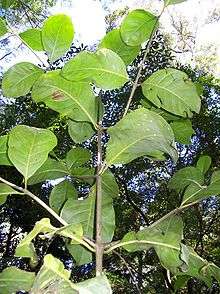Atractocarpus benthamianus
| Atractocarpus benthamianus | |
|---|---|
 | |
| Scientific classification | |
| Kingdom: | Plantae |
| Clade: | Angiosperms |
| Clade: | Eudicots |
| Clade: | Asterids |
| Order: | Gentianales |
| Family: | Rubiaceae |
| Subfamily: | Ixoroideae |
| Tribe: | Gardenieae |
| Genus: | Atractocarpus |
| Species: | A. benthamianus |
| Binomial name | |
| Atractocarpus benthamianus (F.Muell.) Puttock | |
| Synonyms | |
Atractocarpus benthamianus is a species of flowering plant in the Rubiaceae family growing in eastern Australia. It is an understorey species of subtropical and tropical rainforest on fertile soils. The natural range of distribution is from Forster, New South Wales (32° S) to central Queensland. This plant features beautifully scented flowers.
Description
It grows as a woody shrub or small tree and reaches 8 m (25 ft) tall. The trunk does not form buttresses but may be crooked, and is covered by smooth grey bark with horizontal markings and long lenticels. The new growth is hairy in plants found north of Coffs Harbour (30° S) . The large glossy dark green leaves are obovate to lanceolate and range from 8–20 cm (3–8 in) long by 2–4 cm wide, and arranged in whorls of 3-4 on the branches. The veins and midrib are prominent on the leaf. The small white fragrant flowers appear from June to November, occur in clusters of two or three and have five lanceolate petals around a tube. The orange oval-shaped fruit ripens in May to September, and bears 14-18 seeds in a pulp.[1][2] The fragrance of the flowers has been likened to that of the common gardenia.[3]
Distribution and habitat
The range is from Forster (32° S) on the New South Wales mid-north coast north through to Nambour (26° S) in Queensland. It is found in warm temperate to subtropical rainforests in areas of wetter climate.[1]
Uses
Its bushy lush foliage, fragrant flowers and colourful fruit give it horticultural potential in gardens in warm temperate and subtropical climates.[2] It is suited to a shady position in gardens, or moderately to brightly lit indoor spaces.[4]
Taxonomy
Atractocarpus benthamianus was originally described by German naturalist and Victorian State Botanist Ferdinand von Mueller, who named it in honour of the botanist George Bentham, who wrote Flora Australiensis in 1870. It is commonly known as native gardenia.[1]
Known for many years as Randia benthamiana,[2] it gained its current binomial name in 1999 with the publishing of a genus revision by botanists Christopher Puttock and Christopher Quinn.[5]
References
- 1 2 3 Floyd, Alex G. (2009). Rainforest Trees of Mainland Southeastern Australia. Lismore, NSW: Terania Rainforest Publishing. p. 331. ISBN 978-0-9589436-7-3.
- 1 2 3 Elliot, Rodger W.; Jones, David L.; Blake, Trevor (2002). Encyclopaedia of Australian Plants Suitable for Cultivation: Vol. 8. Port Melbourne: Lothian Press. p. 174. ISBN 0-7344-0378-X.
- ↑ Haxen, Phil (February 2005). "Binna Burra, Lamington National Park". Journal of the Tree Society of Zimbabwe. Tree Society of Zimbabwe. Retrieved 2009-08-23.
- ↑ Ratcliffe, David & Patricia (1987). Australian Native Plants for Indoors. Crows Nest, NSW: Little Hills Press. p. 125. ISBN 0-949773-49-2.
- ↑ Puttock CF, Quinn CJ (1999). "Generic concepts in Australian Gardenieae (Rubiaceae): a cladistic approach". Australian Systematic Botany. CSIRO Publishing. 12 (2): 181–99. doi:10.1071/SB98001.
External links
- "Atractocarpus benthamianus". Australian Plant Name Index (APNI), IBIS database. Centre for Plant Biodiversity Research, Australian Government.
- World Checklist of Rubiaceae